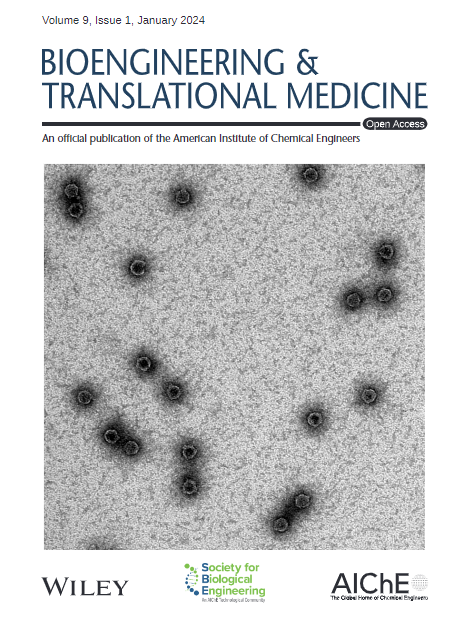一种新型近距离化疗输尿管支架:体外和体内研究
IF 5.7
2区 医学
Q1 ENGINEERING, BIOMEDICAL
引用次数: 0
摘要
输尿管癌仍然是一个主要的临床挑战,需要有效的局部治疗。在这里,我们报道了一种新的125I种子近距离放疗(ISB)和阿霉素(DOX)化疗联合输尿管支架(IUS),它可以同时进行尿引流和放化疗。本研究分为三个部分。首先,在体内研究中,ISB和DOX显著降低T24细胞活力,抑制迁移和侵袭(p < 0.01)。其次,T24异种移植小鼠模型表明,(DOX + ISB)组比DOX (p = 0.08)和ISB (p = 0.02)组表现出更强的肿瘤抑制作用,在体外研究中,Ki‐67和Bcl‐2表达降低,细胞凋亡增加(均p <; 0.01)。第三,IUS成功植入正常beagle犬(n = 30),无手术并发症。输尿管直径随着累积近距离治疗和持续DOX释放的增加而增加(p < 0.05)。组织学分析显示进行性组织损伤和纤维化,在0.8 mCi + 20 mg DOX组中α‐SMA、Caspase‐3和Collagen‐1的表达增加(p < 0.05),而PCNA的表达在对照组(0 mCi + 0 mg DOX)中最高。总之,新设计的IUS在动物试验中是安全的,技术上是可行的;需要进行临床研究来评估其在人类中的应用。本文章由计算机程序翻译,如有差异,请以英文原文为准。
A novel brachytherapy and chemotherapy integrated ureteral stent: In vitro and in vivo study
Ureteral carcinoma remains a major clinical challenge and requires effective localized treatment. Here, we report a novel 125 I seed brachytherapy (ISB) and doxorubicin (DOX) chemotherapy integrated ureteral stent (IUS), which enables simultaneous urinary drainage and chemoradiotherapy. This study was divided into three parts. First, ISB and DOX significantly reduced T24 cell viability and inhibited migration and invasion in an in vivo study (p < 0.01). Second, a T24 xenograft mouse model demonstrated that the (DOX + ISB) group exhibited greater tumor suppression than the DOX (p = 0.08) and ISB (p = 0.02) groups, with decreased Ki‐67 and Bcl‐2 expression and increased apoptosis (all p < 0.01) in an in vitro study. Third, the IUS was successfully implanted in normal beagle dogs (n = 30) without surgical complications. The ureteral diameter increased with increasing cumulative brachytherapy and sustained DOX release (p < 0.05). Histological analysis revealed progressive tissue damage and fibrosis, with increased expression of α‐SMA, Caspase‐3, and Collagen‐1 in the 0.8 mCi + 20 mg DOX group (p < 0.05), whereas PCNA expression was highest in the Control group (0 mCi + 0 mg DOX). In conclusion, the newly designed IUS is safe and technically feasible in animals; clinical studies will be required to evaluate its use in humans.
求助全文
通过发布文献求助,成功后即可免费获取论文全文。
去求助
来源期刊

Bioengineering & Translational Medicine
Pharmacology, Toxicology and Pharmaceutics-Pharmaceutical Science
CiteScore
8.40
自引率
4.10%
发文量
150
审稿时长
12 weeks
期刊介绍:
Bioengineering & Translational Medicine, an official, peer-reviewed online open-access journal of the American Institute of Chemical Engineers (AIChE) and the Society for Biological Engineering (SBE), focuses on how chemical and biological engineering approaches drive innovative technologies and solutions that impact clinical practice and commercial healthcare products.
 求助内容:
求助内容: 应助结果提醒方式:
应助结果提醒方式:


